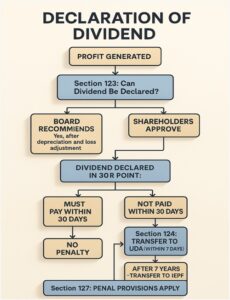Dividends are a portion of a company’s profits distributed to its shareholders as a return on their investment. While dividends reward investors, the law ensures fairness, timely distribution, and accountability by the company’s management.
The Companies Act, 2013 regulates dividend-related activities through:
- Section 123: Conditions for declaration of dividend
- Section 124: Treatment of unpaid or unclaimed dividend
- Section 127: Penalty for failure to distribute dividend
Together, these sections ensure financial discipline, shareholder protection, and penal consequences in case of non-compliance.
Declaration of Dividend
- Sources for declaring dividend:
-
- From current year’s profit after depreciation.
- From past reserves/profits (subject to rules).
- Out of both current and past profits.
- No declaration if company has losses:
- If company has incurred losses in current or previous years, dividend cannot be declared unless these losses are set off.
- Depreciation adjustment:
- Depreciation must be provided as per Schedule II before dividend is declared.
- Transfer to reserves (optional):
- Companies may voluntarily transfer a portion of profits to reserves.
- Dividend on equity shares only after:
- Paying dividend on preference shares (if any).
- Declaration only by the Board and approved in AGM:
- Board recommends, shareholders approve.
Illustrative Example:
If a company earns ₹10 Cr profit in FY 2024-25 and wants to declare dividend:
- Deduct depreciation (say ₹1 Cr).
- Adjust losses (say ₹2 Cr).
- Net profit for dividend = ₹7 Cr.
Unpaid Dividend Account
- Transfer to Unpaid Dividend Account (UDA):
- If dividend is not claimed/paid within 30 days, the company must transfer the amount to a separate bank account called the Unpaid Dividend Account within 7 days from expiry of 30 days.
- Disclosure on Website:
- Within 90 days of transfer to UDA, a statement must be placed on company’s website and MCA website containing:
- Names of shareholders
- Unclaimed amounts
- Within 90 days of transfer to UDA, a statement must be placed on company’s website and MCA website containing:
- Transfer to IEPF:
- Amounts lying in UDA for 7 years must be transferred to the Investor Education and Protection Fund (IEPF).
- Along with the dividend, shares on which dividend has not been claimed for 7 consecutive years must also be transferred to IEPF.
- Claim from IEPF:
- Shareholders can file Form IEPF-5 to claim their dividend and shares back.
🕒 Timeline Summary (Section 124):
| Timeline | Action |
| 30 days from declaration | Dividend must be paid |
| Next 7 days | Transfer unpaid to Unpaid Dividend Account |
| Next 90 days | Publish list of unclaimed holders on website |
| After 7 years | Transfer to IEPF (including shares) |
Punishment for Failure to Distribute Dividend
⚖️ When this section applies:
If dividend is declared in a general meeting and the company fails to pay it within 30 days, penal action is triggered.
🚫 Penalties:
- Every director (knowingly responsible) shall:
- Be punished with imprisonment up to 2 years AND
- Fine of ₹1,000 for every day of default (subject to maximum ₹1 lakh).
- Exemptions from penalty:
No penalty applies if failure to pay dividend is due to:- Operation of law (e.g. court stay)
- Shareholder instructions (e.g. wrong bank details)
- Dispute over ownership
- Adjustment of dividend against dues
- Other reason beyond control of company

